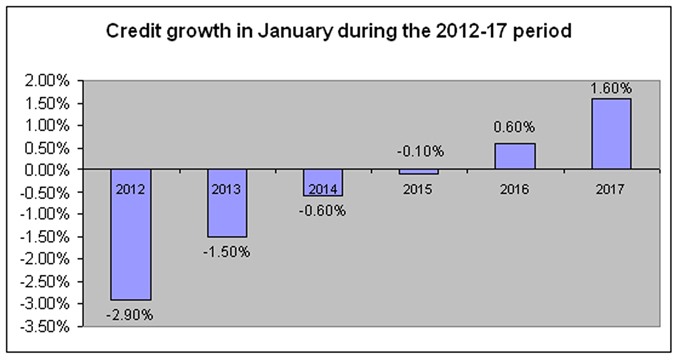 Economy
Economy

The National Financial Supervisory Commission (NFSC) has reported that credit in the first month of the year saw a growth rate of 1 per cent, the highest month-on-month increase over the past five years.
 |
| Source: National Financial Supervisory Commission. — VNS Infographic Ngọc Bích |
HÀ NỘI — The National Financial Supervisory Commission (NFSC) has reported that credit in the first month of the year saw a growth rate of 1 per cent, the highest month-on-month increase over the past five years.
Credit in Vietnamese đồng until January 31 rose by 1.6 per cent from the figure at the beginning of the month, while credit in foreign currencies went up 1.6 per cent in the same period.
In terms of credit structure, short-term lending accounted for 45 per cent of total outstanding loan, while medium and long-term lending made up the rest. The proportion of credit in đồng in the total outstanding loan remained at 91 per cent, the same level as January 2016.
The high credit growth along with the 1.6 per cent decrease in the month’s deposit (compared with the same period last year) made the average credit/deposit ratio increase to 88.2 per cent from 86.8 per cent of the end of last year.
In January, credit institutions experienced slight liquidity pressure, which was reflected in the overnight interest rate recorded at 5 per cent per annum in the month. The rate reduced to 3.65 per cent per annum by March 1.
The State Bank of Việt Nam also had to inject more than VNĐ200.3 trillion (US$8.89 billion) via the Open Market Operation to support liquidity.
According to the commission, there was not much fluctuation in the deposit interest rates in January. However, the market still saw some banks offering interest rates for short-term đồng deposits that were up by between 0.1 and 1.2 percentage points compared with the levels offered before Tết (New Lunar Year).
The commission attributed the increase in deposit interest rates partly to the regulation that the proportion of short-term loans used for medium and long-term lending must not exceed 50 per cent. The regulation came into effect at the beginning of the year.
Meanwhile, lending interest rates were kept stable.
However, according to experts, interest rates are still under pressure.
The research group of the Bảo Việt Securities Company predicted the deposit and lending interest rates this year would likely increase by 0.5-1 percentage per year.
The prediction was made based on three factors. First, the credit would continue growing at high rates (at 17-18 per cent) to support economic development. Second, inflation may also be on the rise, which makes nominal interest rate higher. Last, the US Fed is expected to make three more interest rate adjustments this year and the SBV must maintain a reasonable gap in the rates between the United States and Việt Nam, which would put pressure on đồng interest rates.
Nguyễn Đức Độ, deputy head of the Institute of Economics and Finance under the Academy of Finance, said bad debt is still an obstacle in the banks’ effort to reduce lending interest rates.
According to SBV, the Việt Nam Asset Management Company will have to recover non-performing loans worth VNĐ190 trillion. — VNS




